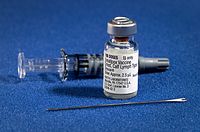
Photo from wikipedia
Variolation, that is, the inoculation of smallpox material in people who have not experienced natural smallpox, appears to have been a prophylactic used for centuries in much of Asia and… Click to show full abstract
Variolation, that is, the inoculation of smallpox material in people who have not experienced natural smallpox, appears to have been a prophylactic used for centuries in much of Asia and North Africa. It was introduced to England in 1721 by Lady Mary Wortley Montagu, the wife of the British ambassador to Constantinople. Although variolation was believed to be safer than naturally acquired smallpox, it was not without danger. In 1722 and 1723, respectively, the English physicians John Arbuthnot (1665–1735) and James Jurin (1684–1750) used the bills of mortality in London in an attempt to compare mortality from natural smallpox with mortality due to variolation. In 1722, Thomas Nettleton, a physician inoculator in Halifax, reported that about one in five patients with smallpox in parts of Yorkshire and neighbouring counties had died, while there had been no deaths among the 61 people whom he had inoculated. Comparisons based on larger numbers in England and New England were subsequently published. These confirmed that variolation was a less risky option when the risk of contracting natural smallpox was increased, but confirmed that the former was not innocuous.
Journal Title: Journal of the Royal Society of Medicine
Year Published: 2018
Link to full text (if available)
Share on Social Media: Sign Up to like & get
recommendations!